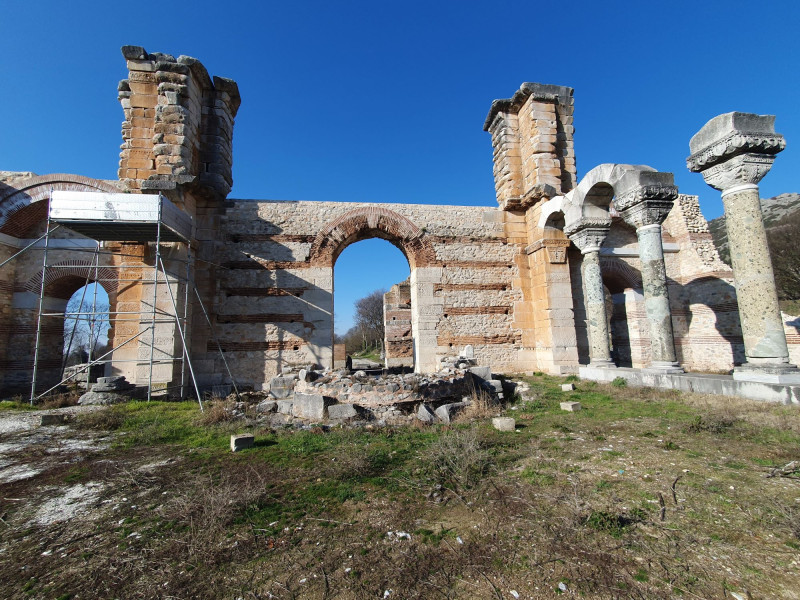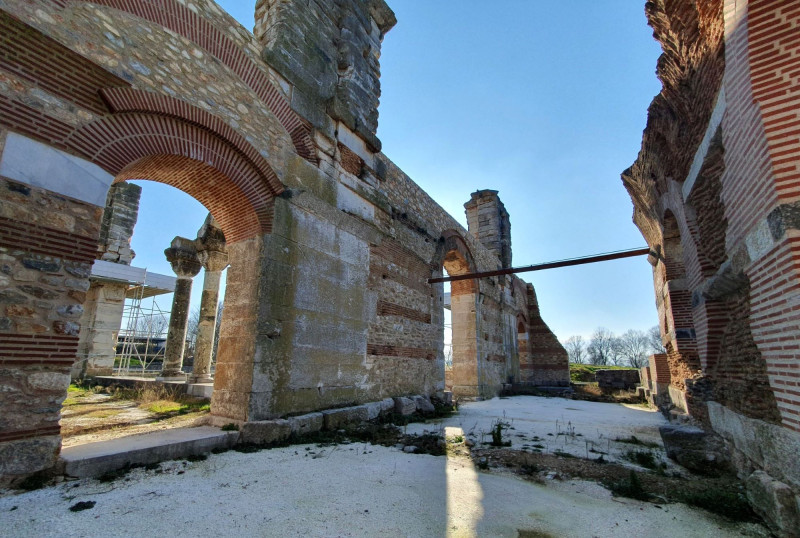With the completion of the work on the west side, the visitor can now clearly see what the entrance of the temple with the narthex looked like
The historic Second Basilica in the famous ancient city of Philippi, one of the most important early Christian monuments of the Greek and world cultural heritage, was restored in its western part, highlighting all the magnificence of the building.
See also: New findings in ancient Philippi – What the fire safety works brought to light – Photos
The imposing early Christian temple is located inside the archaeological site. It was one of the most magnificent buildings of the famous city founded by King Philip in 356 BC. and was visited by the Apostle Paul in 51 AD.
The monument was restored by the services of the Ministry of Foreign Affairs and the final result causes justifiable admiration and impresses.
With the completion of the work on the west side, the visitor can now clearly see what the entrance of the temple with the narthex looked like. At the same time, he now understands to a very large extent the size of the building, the volume it occupied and the magnificence that distinguished it.
At the same time, the interventions carried out ensured the stability of the monument from future disasters as parts of the rescued building presented extensive problems of deterioration. Also, with the interventions made on the ruins of the monument, parts of the building that had been demolished were added -among other things.
For the needs of this idiosyncratic restoration, materials were used that are perfectly consistent with the monument so that there is no alteration of its overall image. In this context, marble stones from old Philippi quarries were also used.
In the coming months, when the delivery process of the project will be completed, visitors will see the ruins and restoration parts of the Second Basilica up close.
At the same time, they will be able to admire for the first time the Vespasian facilities, which are located in the lower part of the temple and were ancient public toilets, which probably formed part of the gymnasium (gymnasium) that existed at that point.
How the central dome of Basilica II collapsed
The Second Basilica is believed to have been built in 550 AD. but it was destroyed before the interior beautification work was completed, when the central dome collapsed. This impressive temple ultimately never functioned.
The study to date leads to the conclusion that the building was probably founded on an older and smaller basilica and this created a series of construction errors. According to scholars, the temple had a brilliant decoration, as the capitals, capitals and appendages, which are excellent examples of decorative art, are among the most important and perfect examples of early Byzantine sculpture and are directly comparable to corresponding members in Hagia Sophia in Istanbul.
Today’s visitor to the ancient city, knowing the history of its construction, can perceive the disappointment and bitterness felt by all its contributors, builders, architects, craftsmen, workers. The failure to build a magnificent church in the city where the Apostle Paul visited, taught and was imprisoned, here where the first European and Greek Christian woman, fellow apostle Lydia Philippisia, was baptized, surely filled the inhabitants with sadness.
The performance in the younger years of the first outdoor T. Operation
The first recorded Divine Liturgy, in recent years, was celebrated on Palm Sunday, April 22, 1934, by the blessed Metropolitan Philippi of Neapolis and Thassos Chrysostomos (later Archbishop of Athens).
In fact, photographs published in the book “PHILIPPI 1914 – 2014 A CENTENNIAL OF FRENCH RESEARCH” have been saved. The Divine Liturgy of 1934 was outdoors and was celebrated in the morning hours in the ruins of the Second Basilica with the presence of a large number of people as evidenced by the photographs of the time.
In modern years, the blessed Metropolitan Prokopios of Philippi, Neapolis and Thassos established, on the day of the feast of the patron saint of Kavala, Apostolos Pavlos, the outdoor vigil at the ruins of the early Christian church under the light of candles and burning torches.
He emphasized that the scattered marbles are “living stones”, which keep alive the history of the ancient city of Philippi and the important events that took place there during the presence of the Apostle Paul and later, when the first Christians began to organize the community them and to establish the first Christian church in Greece.
Source :Skai
I am Frederick Tuttle, who works in 247 News Agency as an author and mostly cover entertainment news. I have worked in this industry for 10 years and have gained a lot of experience. I am a very hard worker and always strive to get the best out of my work. I am also very passionate about my work and always try to keep up with the latest news and trends.












